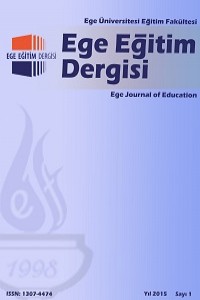Abstract
In this research, effects of traditional teaching and computer assisted teaching methods on student achievements were studied on fractions teaching for math lessons on 112 4 grade primary school students. During the experiment; control group learned with traditional teaching (TT), experiment 1 group learned with classroom-based computer assisted teaching (CBCAT), the experiment 2 group and the experiment 3 group studied in the same class learned with stand-alone computer assisted learning (SACAL), experiment 2 group students studied the Fractions Teaching CD (FTC) completely and experimental 3 group students did not study FTC completely. There were 4 groups in 3 different classes in the study. During the 5 weeks teaching process; FTC evolved by researcher was used in experiment groups and pretest-posttest control grouped experimental design was used. According to results, TT, CBCAT and SACAL methods were successful on students’ achievement of teaching fractions in 4 grade. In comparisons of these three methods, no significant difference was detected (p < .05). However, it can be said that SACAL was more effective than other two methods. At the end of the study teachers’ views gathered about FTC. Teachers stated positive views on teaching lesson with FTC
References
- Aktaş, M., Bulut, M. ve Yüksel, T. (2011). The effect of using computer animations and activities about teaching patterns in primary mathematics.The Turkish online journal of educational technology, 10(3).
- ESRC (2006). Fractions difficult but crucial in mathematics learning.
- http://www.tlrp.org/dspace/retrieve/1754/Nunes+RB+13+Fractions+FINAL.pdf adresinden elde edildi.
- McLeod, R. & Newmarch, B. (2006). Fractions. National Research and Development Center for Adult Literacy and Numeracy.
- https://www.ncetm.org.uk/public/files/257666/fractions_ booklet.pdf adresinden elde edildi.
- Wang, P., Cheng, W., Wang, W. and Hung, P. (2002, Aralık). An elementary school mathematics dynamic learning system and ıts effects. Sözel bildiri, International Conference on Computers in Education (806-807), Auckland.
- Yaylacı, H., S. & Yaylacı, F. (1999). Eğitim teknolojisi dersinde öğretim materyallerinin geliştirilmesi. AKÜ. Sosyal Bilimler Dergisi, 3, 209-219. http://www.egitim.aku.edu.tr/yaylaci.htm adresinden elde edildi.
- Yazgan, Y. (2007). 10-11 Yaş Grubundaki Öğrencilerin Kesirleri Kavramaları Üzerine Deneysel Bir Çalışma. YÖK Ulusal Tez Merkezi veri tabanından elde edildi. (Tez no: 220989)
- -
Abstract
Bu çalışmada ilkokul 4. sınıf matematik dersi kesirler ünitesinin öğretiminde geleneksel öğretim (GÖ) ve bilgisayar destekli öğretimin (BDÖ) öğrenci başarısına etkileri incelenmiştir. Çalışma 112 4. sınıf öğrencisiyle yürütülmüştür. GÖ kullanıldığı kontrol grubu, sınıf tabanlı bilgisayar destekli öğretimin (STBDÖ) uygulandığı Deney 1 grubu, aynı sınıfta kendi başına bilgisayar destekli öğrenme (KBBDÖ) yöntemini tam olarak uygulayan Deney 2 grubu ve KBBDÖ’yü tam olarak uygulamayan Deney 3 grubu olmak üzere 3 sınıf, 4 grup ile yürütülmüştür. 5 hafta süreyle devam eden araştırmada deney gruplarında araştırmacı tarafından geliştirilen Kesirler Öğretim CD’si (KÖY) uygulanmış ve öntest-sontest kontrol gruplu deneysel desen kullanılmıştır.
Sonuçlara göre GÖ, STBDÖ ve KBBDÖ yöntemlerin her biri matematik dersi kesirler ünitesinin öğretiminde 4. sınıf düzeyinde öğrencilerin başarı sağlamasında etkili yöntemlerdir. 3 yöntemin öğrenci başarısı üzerine etkileri kıyaslandığında istatistiki olarak anlamlı bir fark çıkmamıştır (p<0,05). Ancak bulgulara göre KBBDÖ’nün öğrenci başarı puanları ortalamalarında olumlu yönde daha fazla katkı sağladığı söylenebilir. Araştırmanın sonunda öğretmenlerin materyal ve ders hakkındaki düşünceleri alınmıştır. Öğretmenlerin materyale dayalı ders işleme ve geliştirilen materyal hakkında olumlu görüşleri olduğu ortaya çıkmıştır.
References
- Aktaş, M., Bulut, M. ve Yüksel, T. (2011). The effect of using computer animations and activities about teaching patterns in primary mathematics.The Turkish online journal of educational technology, 10(3).
- ESRC (2006). Fractions difficult but crucial in mathematics learning.
- http://www.tlrp.org/dspace/retrieve/1754/Nunes+RB+13+Fractions+FINAL.pdf adresinden elde edildi.
- McLeod, R. & Newmarch, B. (2006). Fractions. National Research and Development Center for Adult Literacy and Numeracy.
- https://www.ncetm.org.uk/public/files/257666/fractions_ booklet.pdf adresinden elde edildi.
- Wang, P., Cheng, W., Wang, W. and Hung, P. (2002, Aralık). An elementary school mathematics dynamic learning system and ıts effects. Sözel bildiri, International Conference on Computers in Education (806-807), Auckland.
- Yaylacı, H., S. & Yaylacı, F. (1999). Eğitim teknolojisi dersinde öğretim materyallerinin geliştirilmesi. AKÜ. Sosyal Bilimler Dergisi, 3, 209-219. http://www.egitim.aku.edu.tr/yaylaci.htm adresinden elde edildi.
- Yazgan, Y. (2007). 10-11 Yaş Grubundaki Öğrencilerin Kesirleri Kavramaları Üzerine Deneysel Bir Çalışma. YÖK Ulusal Tez Merkezi veri tabanından elde edildi. (Tez no: 220989)
- -
Details
| Primary Language | Turkish |
|---|---|
| Authors | |
| Publication Date | July 24, 2015 |
| Published in Issue | Year 2015 Volume: 16 Issue: 1 |
Cited By
Using digital stories to reduce misconceptions and mistakes about fractions: an action study
International Journal of Mathematical Education in Science and Technology
Fatma Gizem Karaoglan Yilmaz
https://doi.org/10.1080/0020739X.2017.1418919
Bilgisayar Destekli Matematik Eğitimi Alanında 2015-2019 Yılları Arasında Yapılan Araştırmaların İncelenmesi
OPUS Uluslararası Toplum Araştırmaları Dergisi
Ali BATTAL
https://doi.org/10.26466/opus.837465
A Content Analysis of the Numbers and Operations Learning Area-themed Articles Published in Turkey Related to Their Topic Trends and Results
Ondokuz Mayis University Journal of Education Faculty
https://doi.org/10.7822/omuefd.1280601
This page is licensed under Creative Commons Attribution-NonCommercial-NoDerivatives 4.0 terms.

